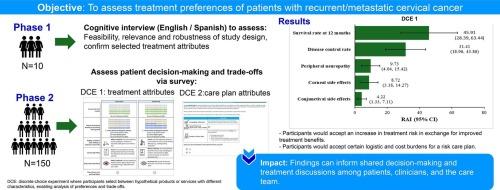复发性或转移性宫颈癌患者的治疗偏好:美国的离散选择实验
IF 1.3
Q3 OBSTETRICS & GYNECOLOGY
引用次数: 0
摘要
目的探讨复发/转移性宫颈癌患者的治疗选择,这是一种预后不良的疾病。方法对美国150例复发/转移性宫颈癌患者进行两项离散选择实验。离散选择实验1包括处理属性,离散选择实验2包括风险缓解计划属性。结果受访患者最看重的是12个月总生存率,其次是疾病控制率;这两种疗效属性都被认为比周围神经病变和角膜副作用等副作用的风险更重要。参与者接受需要降低风险计划的治疗方案的意愿受到诊所就诊次数和自付费用的影响。结论宫颈癌复发/转移患者优先考虑总生存率和疾病控制率。这些发现可用于患者、临床医生和护理团队之间的共同决策和治疗讨论。本文章由计算机程序翻译,如有差异,请以英文原文为准。

Treatment preferences of patients with recurrent or metastatic cervical cancer: a discrete choice experiment in the US
Objective
This study assessed treatment preferences of patients with recurrent/metastatic cervical cancer, a disease with poor prognosis.
Methods
A survey with two discrete choice experiments was completed by 150 patients with recurrent/metastatic cervical cancer in the US. Discrete choice experiment 1 included treatment attributes, and discrete choice experiment 2 included risk mitigation plan attributes.
Results
Participants valued 12-month overall survival rate as the most important attribute, followed by disease control rate; both efficacy attributes were rated as more important than the risk of side effects such as peripheral neuropathy and corneal side effects. Participants’ willingness to accept a treatment profile requiring a risk mitigation plan was influenced by the number of clinic visits and out-of-pocket costs.
Conclusions
Patients with recurrent/metastatic cervical cancer prioritize overall survival and disease control rate as the most important attributes. These findings can be used to inform shared decision-making and treatment discussions among patients, clinicians, and the care team.
求助全文
通过发布文献求助,成功后即可免费获取论文全文。
去求助
来源期刊

Gynecologic Oncology Reports
OBSTETRICS & GYNECOLOGY-
CiteScore
2.00
自引率
0.00%
发文量
183
审稿时长
41 days
期刊介绍:
Gynecologic Oncology Reports is an online-only, open access journal devoted to the rapid publication of narrative review articles, survey articles, case reports, case series, letters to the editor regarding previously published manuscripts and other short communications in the field of gynecologic oncology. The journal will consider papers that concern tumors of the female reproductive tract, with originality, quality, and clarity the chief criteria of acceptance.
 求助内容:
求助内容: 应助结果提醒方式:
应助结果提醒方式:


